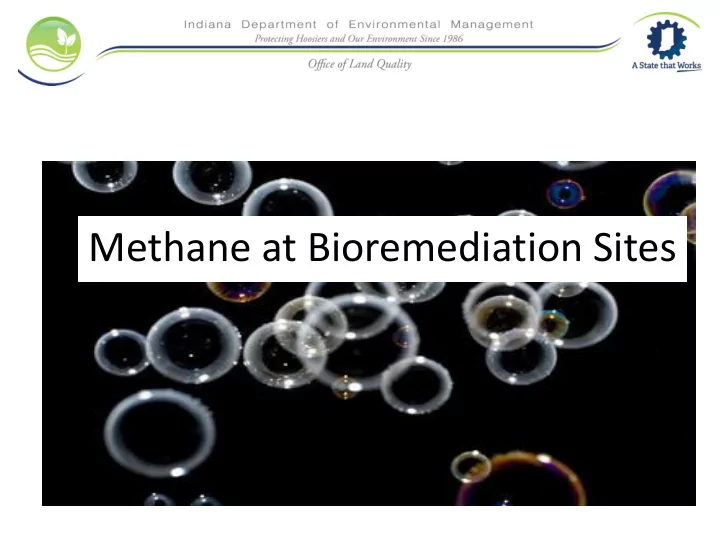

Methane at Bioremediation Sites
Today’s Talk • Why did I write this guidance? • What has been the result? • Answer some frequently asked questions.
Why bother? I haven’t noticed any remediation sites exploding. • Groundwater data where methane exceeds its solubility. • Monitoring well methane gas exceeding the methane lower explosive limit (LEL). • Documented soil gas/sub-slab monitoring points exceeding the methane LEL.
Ethanol in Indianapolis 30 mg/L Ground water methane! Date Methane mg/L 02/12/08 22.490 09/16/08 20.139 02/04/09 12.526 09/10/09 23.282 03/02/10 19.503 09/13/10 31.211 03/22/11 19.606
Please Plan Ahead • Be aware you might generate high levels of methane. • Be prepared to address possible methane issues in your remediation work plans. • Consider the increased cost if you have to mitigate. • Make sure it’s technically feasible if necessary to mitigate.
Initial Thoughts • Goal is to figure out if methane has enough oxygen to attenuate before it has ‘space’ to collect. • Precautionary measure for receptors might be advisable. • Ground water is a good place to start since most reductive dechlorination sites are monitoring methane in ground water.
Initial Thoughts • Soil gas methane in the contaminant source area exceeding 10% of the LEL or ground water exceeding 10 mg/L indicates the need to monitor methane in the direction of receptors.
Initial thoughts • If bioremediation is induced beneath a structure, implement subslab methane monitoring and/or mitigation including the installation of a continuous gas monitor in the lower level of the structure if appropriate. • Indoor air exceeding 25% of the LEL should result in building evacuation until mitigation and a comprehensive methane monitoring plan are implemented.
No Source Area Groundwater Done- Monitor NO > 10,000ug/l or Soil Gas > Quarterly 10% of LEL? Yes Receptors <25% LEL or at the Done- Monitor No Yes Structures Property Quarterly Present? Border? Yes No Initiate methane Anaerobic No monitoring. Are conditions Done- No concentrations Monitor directly greater than 10% Quarterly beneatha LEL at receptors? structure? Yes Yes Yes Mitigation and Possible Mitigation and Possible Evacuation. Evacuation.
FAQs Why does the guidance refer to landfill guidance? Landfills are completely different.
Landfills and remediation sites are the same regarding methane • Electromotive potential (anaerobic) amenable to methanogens. • Place for methane to build to 5-10%. • Ignition source. • No time element. Methane does not have to be generated for thirty years to be a hazard. • Consider nested monitoring wells to gauge attenuation .
Landfills and remediation sites are different Landfill Cleaners
FAQs • Contaminant concentrations aren’t that high at my site. Do I need to worry about methane? • Yes. It’s not the contaminant concentration that matters. A methanogen’s energy source is not the contaminant, it is what you are injecting.
FAQs • What about Petroleum sites? • Concentrations would be applicable. ITRC guidance on ethanol fuels is listed in the references.
FAQs • What frequency should I monitor? • Site-specific determination. – Monthly • Decrease frequency if lines of evidence indicate no issue. • Increase frequency if methane is an issue.
Soluble Carbon Injections Ground water Soil Gas %CH4 mg/L %LEL 04/27/11 0.840 06/21/11 17 08/10/11 21 09/19/11 512 25.6 09/20/11 302 15.1
Soluble Carbon Injections Ground water Soil Gas %CH4 mg/L %LEL 10/28/11 264 13.2 11/29/11 0.290 12/15/11 346 17.3
ERD Injections Enhanced Reductive MMW8S MMW1S Dechlorination Injections Injection Depth: 20-32 ft bgs 14-24 ft bgs 10-20 ft bgs Injection Date: Aug 2007, June 2009, July 2013 ug/L ug/L Ground water at @20 ft bgs 2/28/2013 12,000 54 5/14/2013 8,600 75 9/24/2013 25,000 24,700 11/13/2013 27,400 427 2/26/2014 22,100 162
FAQs • What does intrinsically safe mean? • Generally the electrical components are housed so that the spark can’t get out or the casing is reinforced to withstand an explosion. • National Electrical Code (NEC) and Underwriters Laboratory (UL) define and rate. • $$$
FAQs • I have methane above the explosive limit. Do I need to come unglued? • Maybe. Look at the complete conceptual model. Is there a place for the methane to collect before it has attenuated? It’s hard to get the subsurface to explode. Watch for shallow ground water beneath structures. • Know your site.
References • Eklund, B.; 2010; Proposed Regulatory Framework for Evaluating the Methane Hazard due to Vapor Intrusion; presented at the AWMA Vapor Intrusion Conference; September 29-30, 2010, Chicago, IL; available online at: http://events.awma.org/education/vapor-proceed.html • ITRC (Interstate Technology Regulatory Council); September 2011;: Biofuels: Release Prevention, Environmental Behavior, and Remediation http://www.itrcweb.org/guidancedocuments/biofuels/biofuels-1.pdf . • Kean, Judy; Graves, Duane; Lodato, Mike; Enhanced Reductive Dechlorination and the Relationship Between CIS-1,2-DCE Accumulation and Methanogenesis. Available online at: http://www.drycleancoalition.org/download/enhanced_reductive_dechlor.pdf • USGS. (2006). Methane in West Virginia Ground Water; USGS Fact Sheet 2006- 3011; available online at: http://pubs.usgs.gov/fs/2006/3011/pdf/Factsheet2006_3011.pdf
Contact Information Susan Horein Environmental Engineer shorein@idem.IN.gov (317)-234-4155
Recommend
More recommend